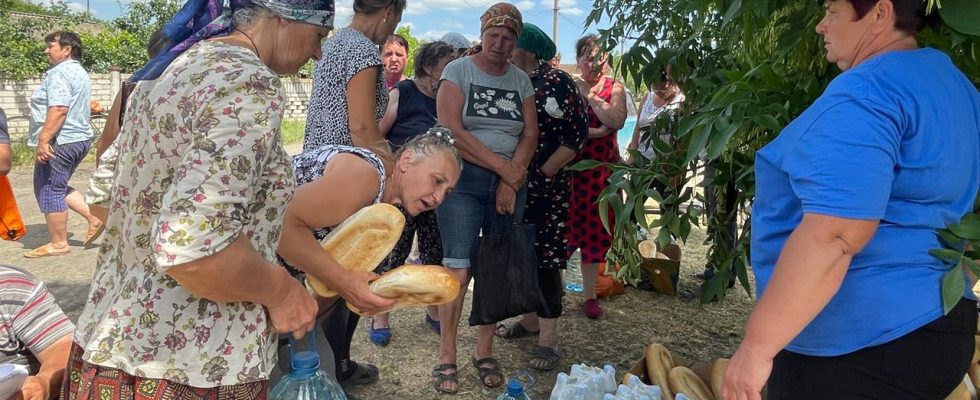People and animals suffer equally after the dam collapse in southern Ukraine. Residents of the Mykolaiv region report on how they are now coping with everyday life – and what the effects of the flood are on the cows, for example.
Irina and Viktoria are sitting on the beach of the Southern Bug in Mykolyav. Around 70 kilometers north of Cherson, there are also backlogs and flooding in this area. Tables and benches of the small beach café, umbrellas, swings and part of the beach are still under water.
The two women in patterned summer dresses are sitting on a bench set back a little and chatting animatedly. The gentle waves also rock a flooded wastepaper basket back and forth. “That squeaking bugs me, but I can’t help it because of the water. At first we thought it was a bird.”
“No one knows when he will die”
The two women laugh, they seem relaxed, and yet they look tired. Before the Ukrainian army recaptured part of the Kherson region in November last year, shifting the front line away from Mykolaiv, the city was heavily shelled by the Russian army. Albeit significantly less than Kherson. The city on the southern Bug was also partially flooded after the destruction of the Kakhovka dam on the Dnipro in the south of the country. “Nothing can shock us anymore,” says Viktoria dryly. “What should we be afraid of? Nobody knows when he will die,” she says.
In the beginning they were very scared, with air raid alarms and the terrible Russian attacks. “I developed inner defenses,” says Irina.
Residents from the flooded village of Afanasiivka bring their belongings to the other bank.
Village Afanasiivka surrounded by water
About 60 kilometers to the east, near Snihurivka, a rubber dinghy belonging to the Ukrainian Disaster Service goes to Afanasiivka. Past houses, fences or trees that were flooded a meter high. The small village is surrounded by several lakes and also lies on the Inhulets River. This has flooded bridges and dams and thus all access points.
The dinghy and a few small ferries are now driving back and forth. They pick up the residents, but they also have cars, furniture, computers, boxes of books, suitcases and stuffed bags on board. In return, they drive medication or groceries to the flooded village.
Almost half of the residents have stayed so far
Fresh white bread and large bottles of drinking water are being distributed on the shore. The bright midday sun is stinging and a few old women in work clothes and headscarves are waiting in the shade of a tree until they are called.
A resolute lady with glasses calls her up and ticks off her handwritten list. “Around 370 people live in Afanasiivka. Although they are trapped by the water, more than half of the people are in the village,” she says. More than 20 children stayed with their parents.
After the dam burst, cows in Afanasiivka are taken to the other side of the river on a small ferry.
Flooded gardens and basements
Even Lida Ivanovna did not get ten horses away from Afanasiivka. “I survived the Russian occupation,” she says. Nothing could frighten her now. She has put her bread and drinking water on the luggage rack of her old bicycle and is now pushing it down the stony village street. Past grazing goats, decaying houses in the flooded part of the village. “Lidia, are you there?” she calls into a courtyard that is half in the water. An old lady asks in, she is depressed.
The basement has flooded and her large garden with potatoes, onions and tomatoes has submerged. “Now everything is gone,” she regrets. The precious harvest is gone, which means an additional burden with the small pensions for old people like Lidia.
Ivanovna scolds as she trudges through the village. She’s heartbroken, she’s sweating, she says she lived under Russian occupation for months. Life continues to be very uncertain and that’s where she becomes fundamental: “We lived peacefully and everyone had enough. And then the ‘Russian brothers’, as they call themselves, came and said they would save us.” Ivanovna snorts. The occupiers went into every house and asked why they lived well in the village. “I said you have to work. You have to work with your hands on the earth. You have to love the soil.”
Animals suffer too
On the shore, some are waiting for the crossing to dry land. A couple of brown cows are also standing in the water, far over their hooves, waiting. They seemingly calmly pluck the green from the trees, which are also under water. “The animals are suffering,” says an old, gaunt man almost affectionately: “Some are very sensitive. They moo quietly and search around. Someone even said they had tears in their eyes. They are torn from their familiar surroundings and taken somewhere else and that scares them.” Then comes the small ferry, which first takes the animals to a meadow on the opposite bank.
The stress of the Russian war of aggression has now become even more of a burden for Viktoria and Irina on the beach in Mykolaiv. They still want to enjoy the moment on the bench, and Viktoria tries to do it with humor. “The bank is actually dry, because only this section is flooded. But it’s great. A piece of Venice, that’s not bad either.”

